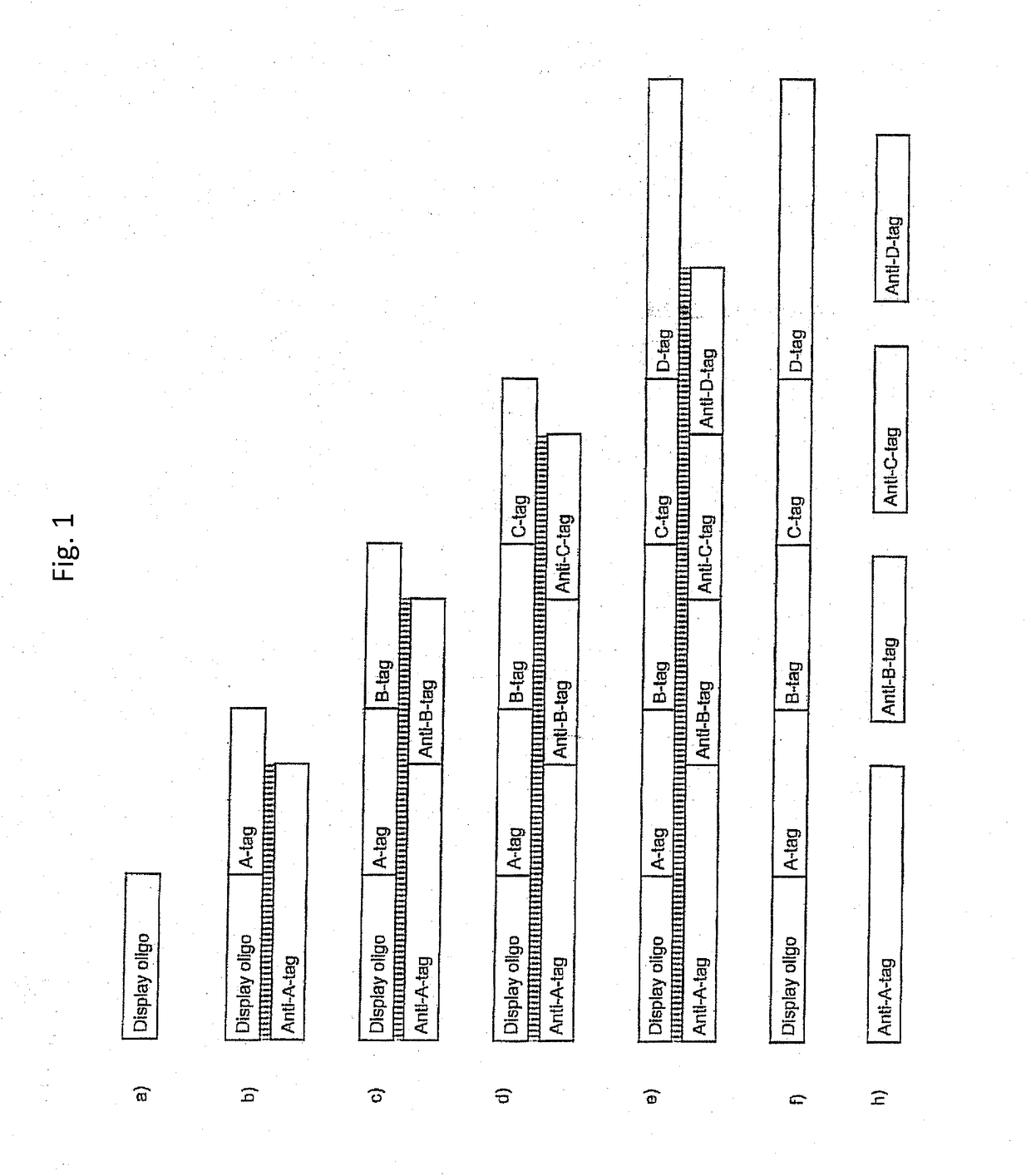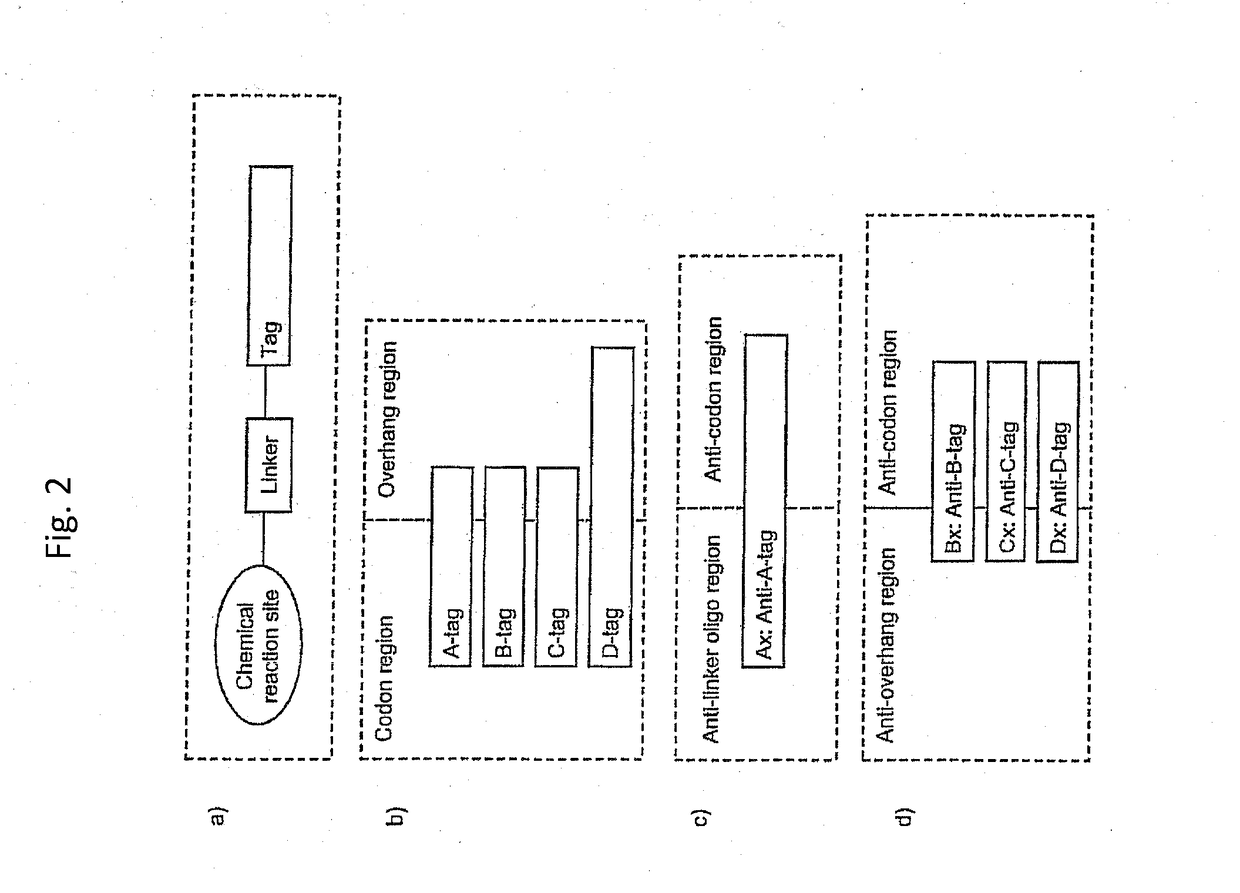Enzymatic encoding methods for efficient synthesis of large libraries
- Summary
- Abstract
- Description
- Claims
- Application Information
AI Technical Summary
Benefits of technology
Problems solved by technology
Method used
Image
Examples
Example
Example
Synthesis and Affinity Selection of a Library Encoding on the Order of 65,000 Scaffolded Compounds
[1432]This example illustrates the use of general procedures in the following order:
[1433]Position A building blocks (reactants) and tags: R1-P1-T1-P1-Q1-V2,
[1434]Position B building blocks (reactants) and tags: T1-P1-R1-P1-Q1-D4-V1,
[1435]Position C building blocks (reactants) and tags: T1-P1-(R1 / R3 / R2)-P1-Q1-V2-D2-V2,
[1436]Position D building blocks (reactants) and tags: T1-P1-(R1 / R2 / R3 / R4 / R5)-P1-D3-V2-P3
[1437]A library on the order of 65,000 DNA-tagged small molecules was synthesized. The synthesized small molecules were scaffolded (branched).
[1438]The first set of building blocks (reactants) (see table 1.5A) were loaded onto a display oligo:
[1439]Subsequently, Fmoc protection groups present on the loaded building blocks (reactants) was removed by incubating them in a solution of 6% piperidine in water at 25° C. for 30 minutes. Samples were then purified using P-6 gel filtratio...
Example
Example 2
Synthesis and Affinity Selection of a Library Encoding on the Order of 85,000,000 Compounds
[1484]A library encoding approximately 85,000,000 compounds was generated using 4 rounds of building block addition.
[1485]The first set of building blocks (reactants) were loaded onto a display oligo:
[1486]Display Oligo
[1487]Subsequently, Frnoc protection groups present on the loaded building blocks (reactants) was removed by incubating them in a solution of 6% piperidine in water at 25° C. for 30 minutes. Samples were then purified using P-6 gel filtration spin columns (Biorad).
[1488]900 pmol Display oligo was added to each of 96 wells. In each well the display oligo carried a specific building block (position A building block).
[1489]Ligation of A-Tags
[1490]10 ul buffer (120 mM Hepes pH 7.8, 40 mM MgCl2, 40 mM DTT and 4 mM ATP) was added to each well. 500 pmol double-stranded A-codons (e.g., the combination A-0001 and Ax-0001) was also added. Annealing was then performed by a 80° C....
Example
Example 3
Bifunctional Complexes Containing One or More Display Molecules(s) and One or More Identifier(s)
[1518]A library is synthesized as described in example 2. At a stage where the bifunctional complexes containing a display molecule (D) are purified and have single stranded identifier oligos, an anchor oligo containing a display molecule (R) is annealed to the single stranded identifier oligos:
[1519]Then an extension oligo (b) is annealed to the single stranded identifier oligo of the bifunctional complexes. The extension oligo is then extended with an enzyme that does not displace or degrade the anchor oligo. The library is then used for selection.
[1520]Using anchor oligos with different display molecules (R) it is possible to modulate the average affinity of the library.
[1521]Alternatively the following display oligo is used during library synthesis:
[1522]The display oligo contains one or more (n) of chemical reaction sites (R), one or more branching linkers (B), one or more (...
PUM
| Property | Measurement | Unit |
|---|---|---|
| Mass | aaaaa | aaaaa |
| Fraction | aaaaa | aaaaa |
| Time | aaaaa | aaaaa |
Abstract
Description
Claims
Application Information
 Login to View More
Login to View More - R&D
- Intellectual Property
- Life Sciences
- Materials
- Tech Scout
- Unparalleled Data Quality
- Higher Quality Content
- 60% Fewer Hallucinations
Browse by: Latest US Patents, China's latest patents, Technical Efficacy Thesaurus, Application Domain, Technology Topic, Popular Technical Reports.
© 2025 PatSnap. All rights reserved.Legal|Privacy policy|Modern Slavery Act Transparency Statement|Sitemap|About US| Contact US: help@patsnap.com



